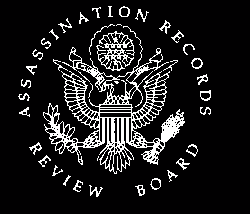
Return to Zavada's Presentation
Return to Zapruder Info Page

The Assassination Records Review Board first met with the Eastman Kodak
Company in June, 1996, in Washington to discuss a wide variety of
possible research topics related to a host of potential film issues. At that
time, Kodak stated that it would provide a limited amount of pro bono work
for the Review Board. The Review Board continued discussions with
Kodak laboratory officials based in Rochester, New York, and
subsequently met with Kodak technical experts James Milch and Roland
Zavada in Washington, D.C. At that meeting, the Review Board identified
three major areas of interest, only one of which related to the Zapruder
film: (1) the possible digitization and enhancement of the Zapruder film,
as well as edge print analysis of the original and first generation copies,
and study of the optical characteristics of the Zapruder camera in relation
to perceived "anomalies" in the original film; (2) the possible enhancement
and, if necessary, optical (i.e., film, not medical) analysis of autopsy images;
and (3) a study of the provenance of film materials subpoenaed by the
Review Board from Robert J. Groden for examination.
Kodak laboratory experts Milch and Zavada viewed the original Zapruder
film, a Secret Service first generation copy, and some of the Groden
materials for the first time at NARA during their September, 1996 visit to
Washington.
Kodak subsequently offered to contribute up to $20,000 of labor and
materials to the Review Board in pro bono work - the equivalent of roughly
35 days of effort. Kodak confirmed, at a meeting with the Review Board in
August of 1997, that Zavada, a retired Kodak film chemist who was formerly
Kodak's pre-eminent 8 mm film expert, was the consultant that Kodak had
hired to:
(1) attempt to write a "primer" explaining the optical and mechanical
operating characteristics of Abraham Zapruder's 8 mm Bell & Howell
home movie camera;
(2) explain the relationship, if any, between the camera's operating
characteristics and perceived "anomalies" in the original film; and
(3) answer questions about the provenance of the original film and the
first generation copies. ("Provenance" issues that Mr. Zavada took on
included studying the chain-of-custody documents executed in November
1963 by Abraham Zapruder; conducting interviews of surviving personnel
involved in the development of the original film, and the exposure and
developing of the three first generation copies; and studying manufacturer's
edge print, processing lab edge print, and the physical characteristics of
the optical printer believed to have been used to create the three first
generation copies on November 22, 1963.)
In addition, in August 1997 James K. Toner, the Laboratory Head of Kodak's
Imaging Science Resources Lab in Rochester, presented a methodology for
making the best possible direct digitization of the original Zapruder film.
Kodak also began to make arrangements with NARA and the Review
Board for the digital preservation and enhancement of the autopsy images
of President Kennedy, under the direct guidance of Toner.
In September 1997, Toner and Zavada visited Washington and, in addition to
studying selected autopsy film and x-ray images at NARA, they also studied
perceived anomalies in the inter-sprocket areas of the original Zapruder
film, and the emulsion characteristics and edge print characteristics of
what NARA presumed to be the camera-original Zapruder film and the two
Secret Service first generation copies. (See the 3 illustrations on page 121
[omitted here].) Following this visit, Zavada began writing his extensive
report on Zapruder film issues, which expanded in scope as his research
into camera optics and printer characteristics continued. This report was
scheduled for completion by Kodak no later than September 30, 1998;
six copies were scheduled for deposit at NARA in the JFK Collection.
Kodak ultimately spent approximately $53,000 on work related to the
digitization and enhancement of the President's autopsy images, and
approximately $11,000 on work related to Zapruder film issues,
significantly exceeding its original estimate of donated labor and
materials. The Review Board gratefully acknowledges the public service
provided to the American people by the Eastman Kodak Company.
The entire Final Report of the Assassination Records Review Board (ARRB) is
now ,
or as a 260Kb .ZIP file you can download and view offline.
Please un-ZIP it to its own DIRectory on your system, and use its "index2.html" as
your starting page.